Antique Diamond Rings
Diamond rings are some of the most consistently popular and desirable pieces of jewellery, and they have been made in many forms over the course of human history. Each time period has crafted these items differently, with variation in form driven by fashion and technology. When you are buying an antique diamond ring you are acquiring a link to the time when it was made – a tangible piece of history that has survived for decades or centuries and passed through many hands since it was first formed.
With such an array of styles and eras available we’ve put together this guide to help you to make an informed decision about which diamond ring will be right for you.
Which Period?
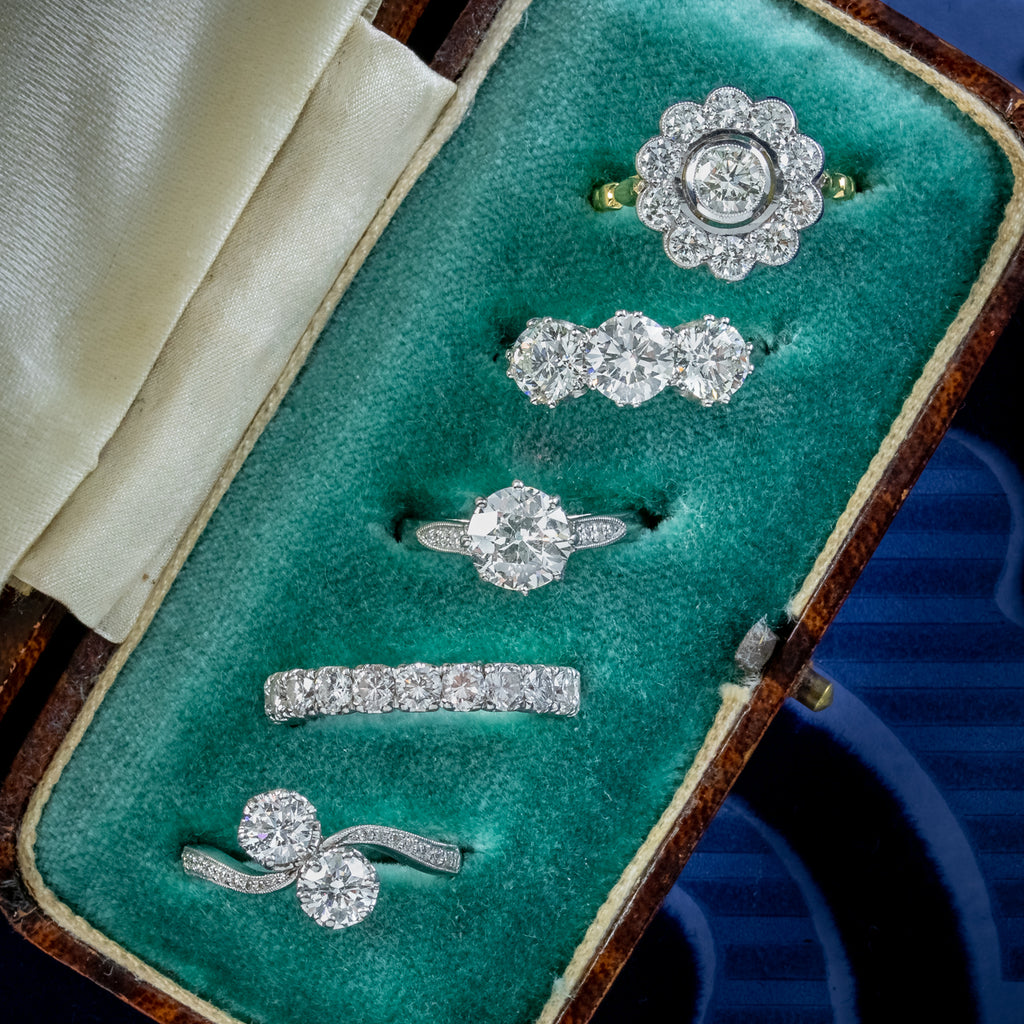
Before you choose your antique diamond ring it’s worth considering a little about the era you are interested in. The older the ring the higher a price it can command, as there are likely to be less surviving specimens from earlier times. Truly ancient jewellery is very rarely traded with the general public, so the vast majority of antique rings for sale were made between the years 1714 and 1935.
Let’s take a look at the characteristics of diamond rings from four of the key periods.
Georgian Diamond Rings

The years between 1714 and 1830 are known as the Georgian period as during this time Great Britain was ruled by four successive kings named George. Jewellery from this time shows the first evidence of the technological improvements of the Industrial Revolution. Advances in both metallurgy and the shaping of precious stones can be seen when comparing early Georgian and late Georgian rings.
Diamonds were even rarer at this time than they are today, and their extreme hardness meant that they took a great deal of time to shape. This meant that every piece of diamond jewellery was completely unique, and that craftsmen took a great deal of time to make them. Georgian jewellers preferred the rose cut; a flat back with an array of triangular facets across the front. The facets could be modified to create round, oval and teardrop shapes to allow the gem to pair with the ring’s structure.

At this time jewellers worked with high carat gold, which is extremely soft by comparison to more modern alloys. This meant that the diamond often had to be surrounded with gold to ensure that it could not be easily knocked loose. Because this prevented light from flowing through the sides of the stone it was backed with a highly polished foil of bright metal that allowed the light from the exposed facets to be reflected back and brighten the stone.
Due to their rarity, high value gold, and bespoke construction Georgian diamond rings are most valued by jewellery collectors with a keen interest in history.
View our collection of Georgian diamond rings
Victorian Diamond Rings

The reign of Queen Victoria was marked by unprecedented wealth and innovation. Gem cutters benefited from improvements in the tools available, allowing them to cut diamonds faster and with increased accuracy. This led to a decline in the popularity of the rose cut as more elaborate forms, such as the old mine and old European cuts, became the standard. These shapes are more akin to modern diamonds, with a greater number and variety of facets across the face. The back of these cuts is similar to a modern diamond, although the culet where the facets come together is sliced across. This means that Victorian diamonds often show a small black dot when viewed directly from the top.
During this time metallurgists succeeded in creating lower carat gold alloys which bonded the pure gold with other, stronger metals to produce more durable materials for jewellery making. These were extensively employed in Victorian diamond rings, and allowed for the fashioning of slimmer, more delicate designs which did not put the stone at risk.
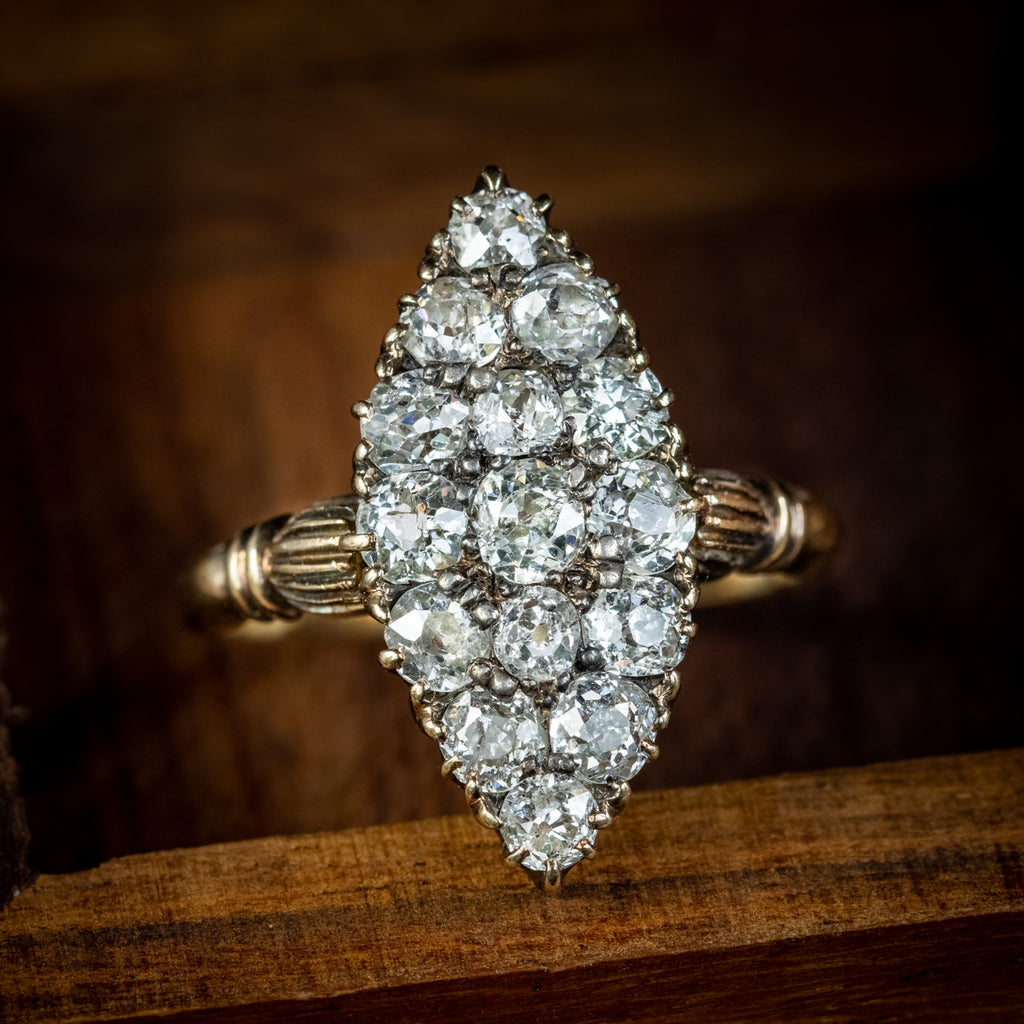
Victorian jewellers could now use small prongs at the side of diamonds to hold them in place securely. This, in turn, allowed them to add clusters of diamonds without impeding the flow of light. These rings had no need for foil-backing and the practise fell out of use. In its place jewellers were able to create intricate wire work and more open pieces that took advantage of the new metal’s strength.
These advances in the jewellers’ art, means that Victorian diamond rings vary tremendously in style and shape. These pieces were made in larger quantities than was possible in earlier eras, so collectors can locate a greater number of surviving pieces.
View our collection of Victorian diamond rings
Edwardian Diamond Rings
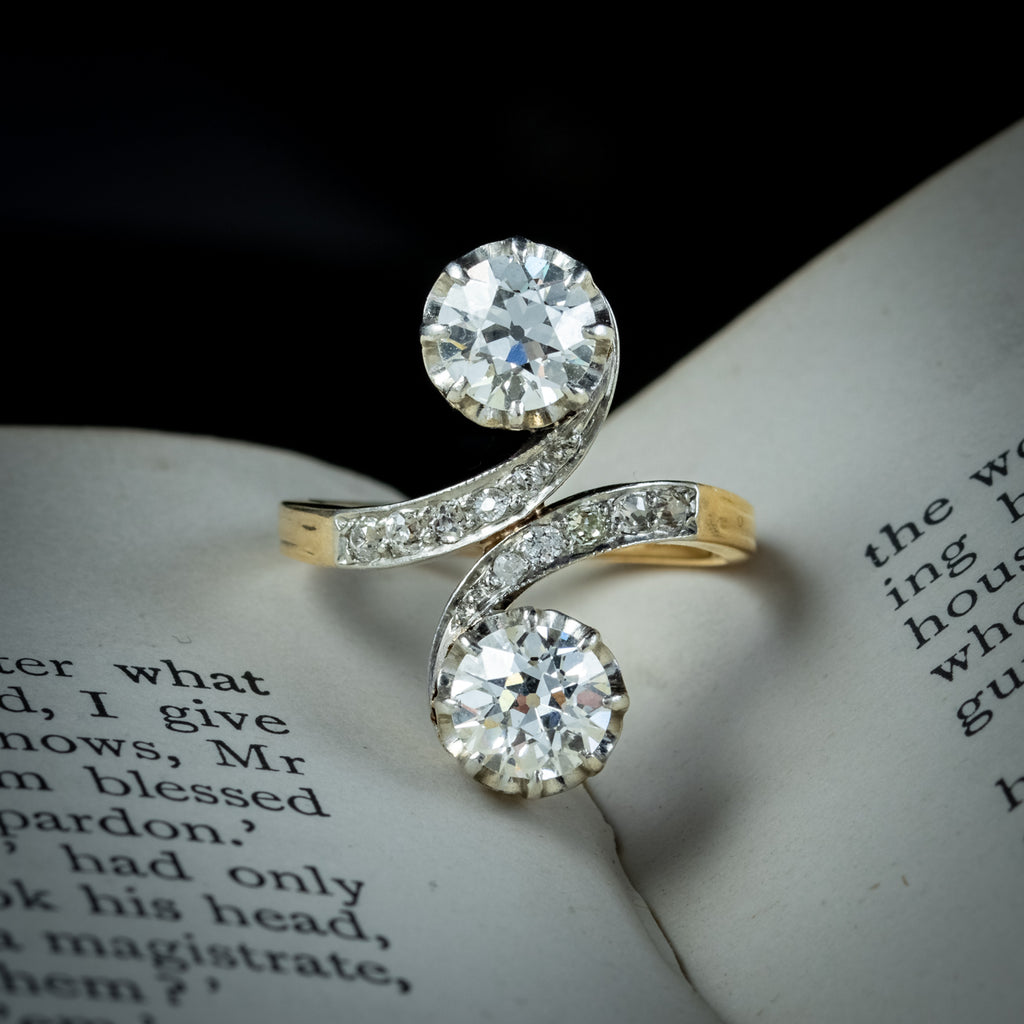
Queen Victoria’s eldest son Edward reigned for only thirteen years, a fraction of his mother’s tenure as monarch, yet this period was still hugely influential. The Edwardian era was characterised by beauty and excess, earning it the name “Belle Epoch” or “Beautiful Era”.
It was during this period that the metalwork pioneered during the Victorian era really came into its own. Edwardian diamond rings were marked by extremely elaborate wire work and engraving, as well as slim, delicate and complex forms that would have been impossible in earlier times. Towards the end of the Victorian era gem cutters had begun to use the brilliant cut, which is the standard for most modern diamonds, but it was during the Edwardian era that it rose to prominence. These cuts had more facets than the old mine or European forms, giving them a greater amount of sparkle. They also had pointed culets, which eliminated the dark spot at the centre of the stone and magnified the scintillation of the diamond.

Edwardian diamond rings are rare treasures, as it is the shortest of the four periods covered here, but they are amongst the most beautiful pieces of jewellery in existence; each one a true tribute to the Belle Epoch.
View our collection of Edwardian diamond rings
Art Deco Diamond Rings

Art Deco was the first truly international movement in art and design, influencing everything from architecture and vehicles to furniture and fashion. It had a profound impact on the design of jewellery. Art Deco diamond rings abandoned the flowing forms of the past to embrace stark geometric shapes and bold, machine assisted innovations. The movement was characterised by a sense of hope and faith in human progress which shines through the designs of the day.
Art Deco jewellers often avoided yellow gold in favour of the newly popular white gold and the much more valuable platinum. Both of these bright, silvery metals pair extremely well with diamonds.
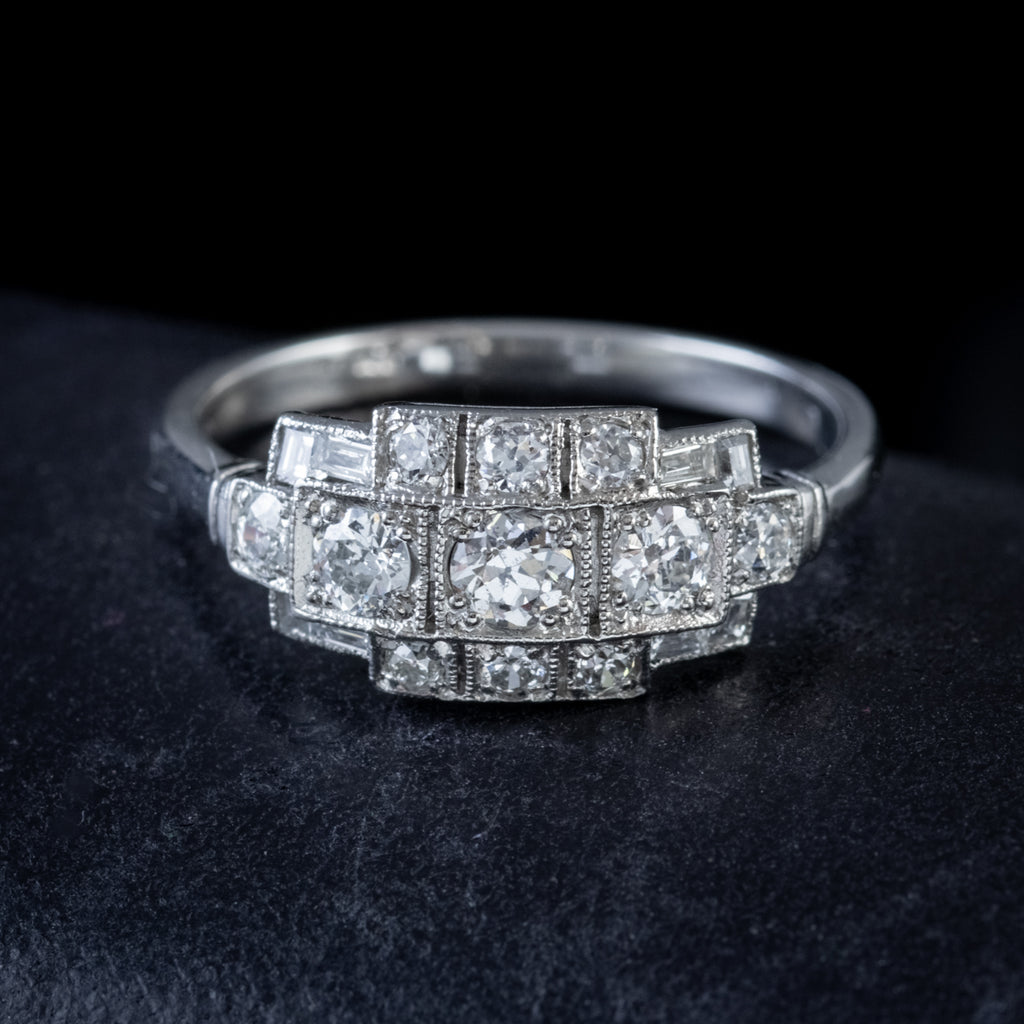
Whilst Art Deco diamond rings were undoubtedly extravagant they also could also express a streamlined aesthetic. Elaborate cluster designs were pared down so that a smaller number of extremely high quality stones could combine to produce a dazzling effect in a more efficient way.
These pieces are popular with those who have a keen interest in art itself, and the Art Deco style particularly. They are wonderful examples of the traits which caused the movement to take hold of so many aspects of culture.
View our collection of art deco diamond rings
At Antique Jewellery Online we are passionate about diamonds, and rings in particular. View our collection of diamond rings and other diamond jewellery
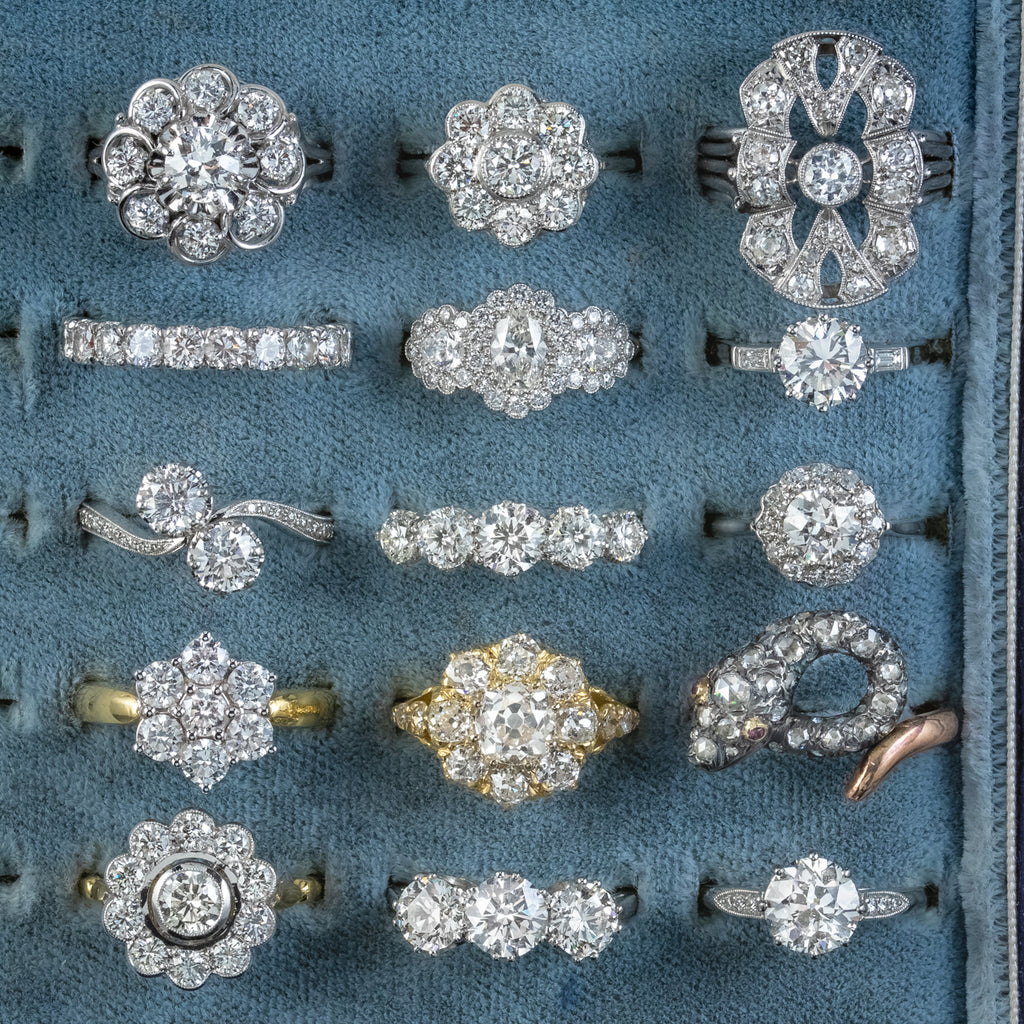
Looking for a particular piece? Why not get in touch and see what our team can do for you? Call us on England: 0333 700 4500; or send us an email at enquiries@antiquejewelleryonline.com.

